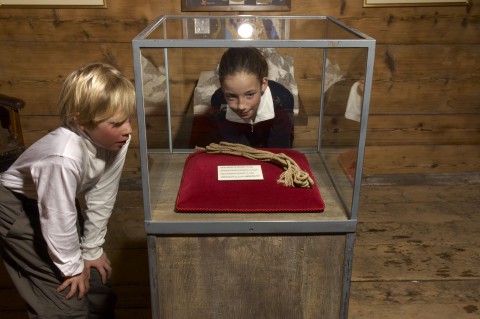It was at 5.30 in the morning on Thursday 13th July 1865 that Edward Whymper and seven others set out from the Monte Rosa hotel in Zermatt on what was to be one of the most significant adventures in mountaineering history: the conquest of the Matterhorn.
During the previous four years the young London-born artist had made several failed attempts to climb the iconic peak on its Italian south-west ridge but, on this occasion, he would try the north-east facing “Hörnli’ ridge on the Swiss side.
A mixed climbing party
That morning’s party had come together as a result of a series of last minute chance meetings. In addition to Wymper, it comprised an English nobleman, Lord Francis Douglas, an Anglican chaplain, the Reverend Charles Hudson, his young protégé, Douglas Hadow, a French mountain guide, Michel Croz, and three Zermatters, Old Peter Taugwalder and his two sons.
The ascent
Passing Schwartzsee where a cache of equipment was waiting for them, they carried on along the ridge, stopping to make camp at midday at a height of 3380m, some 100m above the location of the present-day Hörnli refuge.
The following morning at dawn, one of the Taugwalder boys returned to the village, leaving the remainder of the group to continue up, individually at first and then roped together.
In good conditions, they climbed until some 70m below the summit when Whymper and Croz detached themselves from the others and raced to the top where they arrived at 1.40pm.
First to the Summit
Whilst the remainder of the group made their way to the summit ridge which runs along the border between Switzerland and Italy, Whymper satisfied himself of the absence of any other footprints.
It was then that he spotted his rival, the Italian guide Jean-Antoine Carrel, with a party of climbers some 200m below on the Italian ridge and on catching sight of him already on the summit, they decided to return to the valley.
A tragic descent
Having rested, Whymper’s party started the arduous descent with Croz leading on the rope, followed by Hadow, Hudson and Douglas, with Taugwaulder senior, Whymper and finally young Taugwalder bringing up the rear.
They climbed down slowly with just one man moving at a time but then, less than an hour from the summit, the inexperienced Hadow lost his footing and fell onto Croz, dragging Hudson and Douglas with him.
On hearing Croz’s shout from below, Whymper and the two Taugwalders managed to find secure holds but with the shock of the lower four men’s fall, the rope broke and the unfortunate quartet dropped to the glacier below and to their deaths.
Unable to help their colleagues, the three survivors proceeded with the descent until 9.30pm when they rested for the night before starting again at dawn to arrive back at Zermatt later that Saturday morning.
Was anyone to blame?
Over the years, much has been said and written about that fateful expedition. Whymper had to answer to charges of negligence whist Taugwalder senior was even accused of cutting the rope between him and Lord Francis Douglas to save himself and, although acquitted, many of his fellow Zermatt guides were never convinced of his innocence.
150th anniversary
This summer sees the 150th anniversary of these historic events and in celebration of the jubilee, the Zermatt tourist office has organized an entertaining programme of festivities between 10th and 18th July.
These include a dramatization of the first ascent, the opening of the newly renovated Hörnli refuge and the illumination of the ridge itself during a night climb by local mountain guides.
Come to Zermatt this summer and see the remains of Whymper’s broken rope in the Matterhorn museum.
For more information about the anniversary events go to http://www.zermatt.ch/en/150
Article by Ed Mannix, owner of www.matterhornchalets.com

